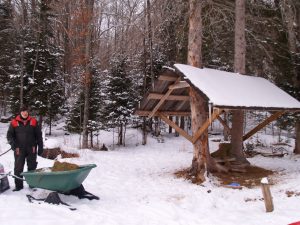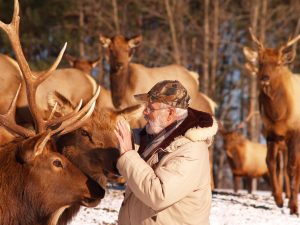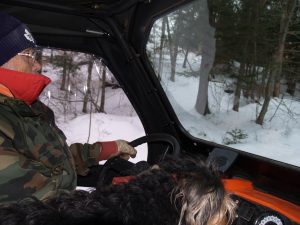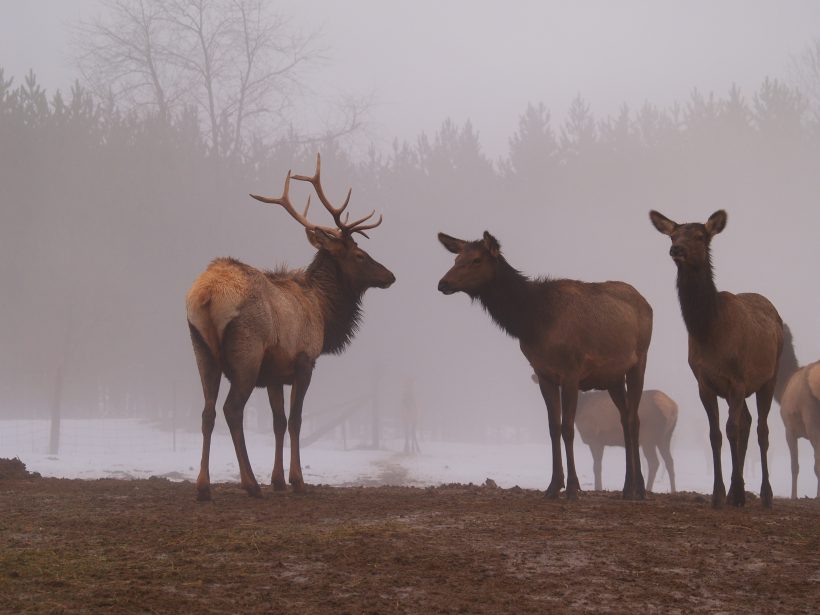ELK MORTALITY
In 2001 Elk Island’s Rob Kaye, Senior Park Warden, and Norm Cool, Wildlife Biologist, visited the Ginn Lake site to survey the scene of the re-introduction of “their” elk. Although they didn’t catch as much as a glimpse of any elk the radio collars indicated the animals’ presence. The Albertans were interested to see how far the elk had traveled since their arrival and release and the variety of habitat within which they survived. Of the 120 elk released in two years 98 were still alive. Cool said that mortality rate was about “what’s expected.” However, approximately 20 calves had been born during that time. The reader can do the math.
Most of the elk fatalities were accidental deaths, involved wolves, vehicles (such as on Highway 401) or hunting incidents when they were mistaken for the white-tail deer.
In fact, in 2000, on Friday, November 10, during the two week rifle season for deer, the first elk to be shot was affectionately known as “Monty.” Monty had overwintered in the Monteagle area of North Hastings (north of Bancroft) before she traveled across Algonquin Provincial Park and relocated in the Baysville area, south of Huntsville. Monty had a calf with her at the time. The calf was nowhere to be seen. A second elk, a mature bull, was killed on Saturday, November 11 by a Green Lake area camp hunter. As the crow flies, Green Lake, in Ashby Township, is not far from the release site at Ginn Lake. Usually the guilty parties, once they became aware of the error of their way, called the Ministry of Natural Resources and turned themselves in. The court pattern that evolved involved going before a Justice of the Peace. Fines went to the MNR’s special purpose account to help fund ministry fish & wildlife activities and “voluntary” donations went to the Elk Restoration Project. Although the maximum allowable fine was $25,000 nothing so harsh has ever been imposed.
The re-introduction committee aimed to look on the positive side of such accidents. “Maybe the information gathered from these animals and circumstances can provide insight into the quality of habitat, the effects of migration and potential new release sites,” said John O’Donnell. “For example Monty was shot in what appears to be prime elk habitat.” He also pointed out that the Green Lake Hunt Camp was distraught. It was a tragic mistake “but once you pull the trigger you can’t call the bullet back.”
As an aside members of this camp have gone on to volunteer thousands of hours and dollars towards supporting this re-introduction project and on-going research. In fact as of 2008, since this group began fund raising in 2000, they have contributed $100,000 towards the elk project.

The 2001 deer season was something of a disaster for the North Hastings release with 5 illegal elk kills. Conservation Officers were also investigating another old kill but all they had to go on was some hair and bones in Elzevir Township, Peterboro. The 5 current kills were: 1. Cow shot and found in Denbigh Township, Bancroft District; 2. Bull shot and found in Mayo Township 300 metres from a heavily traveled access road, Bancroft District; 3. Bull shot in Elzevir Township, Peterboro District, the hunter turning himself in; 4. Cow found shot in a farmer’s field near Highway 401 in Tyendinaga Township, Peterboro District; and 5. Cow shot in Blithfield Township, Pembroke District, the shooter turning himself in. Barry Wannamaker, Co-chair of the Local Elk Committee, took the high road stating that two hunters turned themselves in, (“the guy in Pembroke could have cut and run because his elk had no collar and no one would have been wiser”), one elk had a collar valued at $5000 which was returned and the MNR had more carcasses for scientific study. He also said the guys in Denbigh were very cooperative and helped him load the elk for transport.
In April 2001 an elk survey said the herd was in good shape. The accompanying report said there was a confirmed 40% reproduction rate, “probably higher. The calves and cows are in tremendous condition.”
The year 2002 was one of those “good news, bad news” years for the elk. The good news? No elk were shot during the two week rifle season for white-tails. Perhaps the 25 signs that focused on elk awareness paid some immediate dividends?
The bad? The third shipment of elk from Alberta was put on hold while the MNR further studied the CWD (chronic wasting disease) situation in Ontario. In time the MNR would decide against any further elk transfers. (As of 2008 the very vigorous CWD ministry tests have yet to find one case in wild deer or elk. Rick Rosatte, Senior Research Scientist with the Ontario Ministry of Natural Resources, said in December 2007, “since 2002 about 5,000 deer and approximately 100 elk have been tested for CWD” and all have been negative. ) CWD is a degenerative, fatal brain disease that affects white-tailed deer, elk, and mule deer. While similar to BSE or “mad cow disease”, there’s no evidence it can be transmitted to humans or to domestic livestock.

In June 2002, O’Donnell said that Al and Mary Russell, west of Fraser Lake near Boulter, east of Bancroft, reported watching a newborn spotted elk calf “about 1 ½ feet tall” grazing along side its mother, a small uncollared cow. O’Donnell theorized that the small cow would have been born to one of the first re-introduced animals in the spring of 2000 making this calf” the first completely naturalized Ontario elk.” Of all the calf reports this was the first of one with an uncollared cow.
The radio collars were programmed to automatically come off the elk after a year for collection for further research. Technology is grand – when it works. However, some of the collars malfunctioned and stayed on the host elk’s neck. Bring on Bighorn Helicopters of British Columbia and shades of the popular television show Wild Kingdom featuring Marlin Perkins. As the helicopter pilot swooped down upon an elk still wearing a collar an employer would jump from the helo and net his target elk. The jumper would very quickly remove the collar from the shocked elk and off they would go seeking another. Time was money and they had to move quickly. Safely but quickly.
On November 10, 2003, a deer hunter made some remarkable shots and killed a running cow and elk calf in Cashel Township. He turned himself in and was ultimately fined $500. He also voluntarily donated $2000 to the Bancroft/North Hastings Elk Restoration Committee. Following a 10-month investigation which involved forensic evidence which matched a bullet retrieved from an abandoned elk and a firearm an Etobicoke man was finally charged in late October 2002. On January 7, 2003, the accused appeared in the Ontario Court of Justice in Bancroft where he was fined $3000 plus a voluntary donation of $1000 to the Bancroft/North Hastings Elk Restoration Committee. His hunting licence was also suspended for one year. There were no such hunting fatalities in 2004 however a bull elk in his prime was injured in a collision with a car near Renfrew in Late September and the MNR had to put him down. On October 8, a member of a Lower Turriff area hunt camp discovered another prime bull elk. Cause of death was uncertain although it did have an injury to the right flank perhaps the result of some sparring with another bull. The bull wore ear tag #352 telling researchers that it arrived in 2001. Post release the bull traveled to the Millbridge area and then over to Rice Lake where he earned the name “The Roseneath Bull.” As he became something of a nuisance in 2002, the bull, according to The Bancroft Times, was airlifted by Bighorn Air out of British Columbia. The helo team darted him, netted him and “off-loaded” the elk near Mephisto Lake in Hastings County where he spent two years. Then he moved to become one of the “Turriff Group” for the fall rut when he was finally discovered in a field with four females standing nearby his carcass. Dr. Rick Rosatte, Senior Research Scientist with the Ontario Ministry of Natural Resources, said it appeared that the Turriff bull was killed in an apparent fight with another elk. By 2004, before the calf report, the 120 elk that had been re-introduced now numbered approximately 200. “Two out of 200 is really good,” said Rosatte. “Normal mortality in a wild population out west is 20 to 30 per cent.” The anticipated calf numbers could escalate the herd to 250-320. The elk population had been increasing at the rate of approximately 20% per year. “The gestation period is about 250 days,” Rosatte added. In the meantime, several habitat improvement projects were underway being “seeded with a special wildlife forage seed mixture” in an attempt to draw the elk away from prime agricultural crops in late summer and to separate the winter deer and elk herds while acting as an alternative to the winter feeding stations currently in use. According to Jim Young of the Provincial Elk Restoration Committee the Ontario re-introduction had cost $1.28 million by 2004.

2005 could be called the year of poor ice for some unfortunate elk. On January 7, 2005, Joe Neuhold, the Elkman, discovered that a young bull elk had fallen through the Gin Lake ice. Then, on February 25, Bud and Alice Hannah alerted John O’Donnell that a young bull elk had fallen through the ice on Aide Creek, a tributary of the Little Mississippi River. Upon investigation they discovered a second elk; a three to four year old cow had fallen through the same hole in the ice. O’Donnell said that the creeks had taken their toll that year and all three that went through the ice were about the same age. “All were born here,” he said. About the same time MNR Wildlife technician Tom Simpson was picking up another elk which had died in the Turriff area for no immediate apparent cause. A fourth elk had been killed in a vehicular collision and a fifth in a rut with another bull. A sixth elk was shot on November 19, 2005, ironically the last day of the deer gun season. By this time the elk restoration project had cost some $2.4 million with the Local Implementation Committees (LIC) raising about $45,000 a year to run their programs.
There were no accidental shootings in 2006, however hunters during the second week of the deer hunt discovered a magnificent bull in the Queensborough area north of Belleville. Apparently, it had died from an infection due to an injury, perhaps from the rut. “It definitely did not die from a gunshot,” said MNR’s Dr. Rick Rosatte. “I radio-collared this animal as a calf at Elk Island National Park, Alberta. It was released at Gin Lake in Ontario in 2000. It was about 7.5 years old when it died.” The bull’s 7-point rack measured 45 inches long and the animal dressed out at 773 pounds. In 2007 a bull and a cow elk were shot, again mistaken for deer. The hunters turned themselves in.

PRESENT/PAST ELK NUMBERS LOCALLY – update in March 2008 from Rick.
